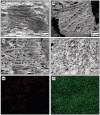Ice-Template Crosslinked PVA Aerogels Modified with Tannic Acid and Sodium Alginate
- PMID: 35877504
- PMCID: PMC9321210
- DOI: 10.3390/gels8070419
Ice-Template Crosslinked PVA Aerogels Modified with Tannic Acid and Sodium Alginate
Abstract
With the commitment to reducing environmental impact, bio-based and biodegradable aerogels may be one approach when looking for greener solutions with similar attributes to current foam-like materials. This study aimed to enhance the mechanical, thermal, and flame-retardant behavior of poly(vinyl alcohol) (PVA) aerogels by adding sodium alginate (SA) and tannic acid (TA). Aerogels were obtained by freeze-drying and post-ion crosslinking through calcium chloride (CaCl2) and boric acid (H3BO3) solutions. The incorporation of TA and SA enhanced the PVA aerogel's mechanical properties, as shown by their high compressive specific moduli, reaching up to a six-fold increase after crosslinking and drying. The PVA/TA/SA aerogels presented a thermal conductivity of 0.043 to 0.046 W/m·K, while crosslinked ones showed higher values (0.049 to 0.060 W/m·K). Under TGA pyrolytic conditions, char layer formation reduced the thermal degradation rate of samples. After crosslinking, a seven-fold decrease in the thermal degradation rate was observed, confirming the high thermal stability of the formed foams. Regarding flammability, aerogels were tested through cone calorimetry. PVA/TA/SA aerogels showed a significant drop in the main parameters, such as the heat release rate (HRR) and the fire growth (FIGRA). The ion crosslinking resulted in a further reduction, confirming the improvement in the fire resistance of the modified compositions.
Keywords: aerogel; crosslinking; fire resistance; lyophilization; tannic acid.
Conflict of interest statement
The authors declare no conflict of interest.
Figures







References
-
- Verma A., Thakur S., Goel G., Raj J., Gupta V.K., Roberts D., Thakur V.K. Bio-Based Sustainable Aerogels: New Sensation in CO2 Capture. Curr. Res. Green Sustain. Chem. 2020;3:100027. doi: 10.1016/j.crgsc.2020.100027. - DOI
-
- Mao J., Iocozzia J., Huang J., Meng K., Lai Y., Lin Z. Graphene Aerogels for Efficient Energy Storage and Conversion. Energy Environ. Sci. 2018;11:772–799. doi: 10.1039/C7EE03031B. - DOI
-
- Wang L., Sánchez-Soto M., Maspoch M.L. Polymer/Clay Aerogel Composites with Flame Retardant Agents: Mechanical, Thermal and Fire Behavior. Mater. Des. 2013;52:609–614. doi: 10.1016/j.matdes.2013.05.096. - DOI
Grants and funding
LinkOut - more resources
Full Text Sources
Other Literature Sources
Miscellaneous

